I read on a forum somewhere a comment relating to an individual’s initial response to the Leica M-A as being – in their words – “underwhelming”. When I first read this comment I didn’t think a great deal of it, it was just another comment on just another forum; I dismissed it as an empty or shallow opinion from just another naysayer. That’s pretty much the usual response to forum commentary I feel in someway doesn’t echo my own views, there is so much of it that it’s easier just to filter and disregard as much of it as quickly and effortlessly as possible. Of course, dismissal of this comment on my part was at best unfair to this person, but it was also entirely shortsighted. I hadn’t even seen a Leica M-A in the flesh at the time, so how could I possibly judge the validity of the statement? Well basically I assumed that being underwhelmed by something that’s pictures I had all but drooled over would be impossible. I was wrong, when I first played with a Leica M-A, I was also somewhat underwhelmed.
First contact
I saw the Leica M-A for the first time at the Photography Show at the NEC in late March. My main mission for the day was to find the person at the Leica stand who was in a position to make the decision to loan me a Leica M-A for me to fondle review. I found said person and after a quick chat it was decided I could borrow the review copy just as soon as it was available. Brilliant. But whilst I was there I wanted to have a quick go with an M-A. I’d even taken along my recently serviced M3 and M7 to compare it to. Upon picking it up, all of a sudden I completely understood this persons comment. That isn’t to say that I thought it was in some way poor, just there wasn’t anything about it that knocked my socks off.
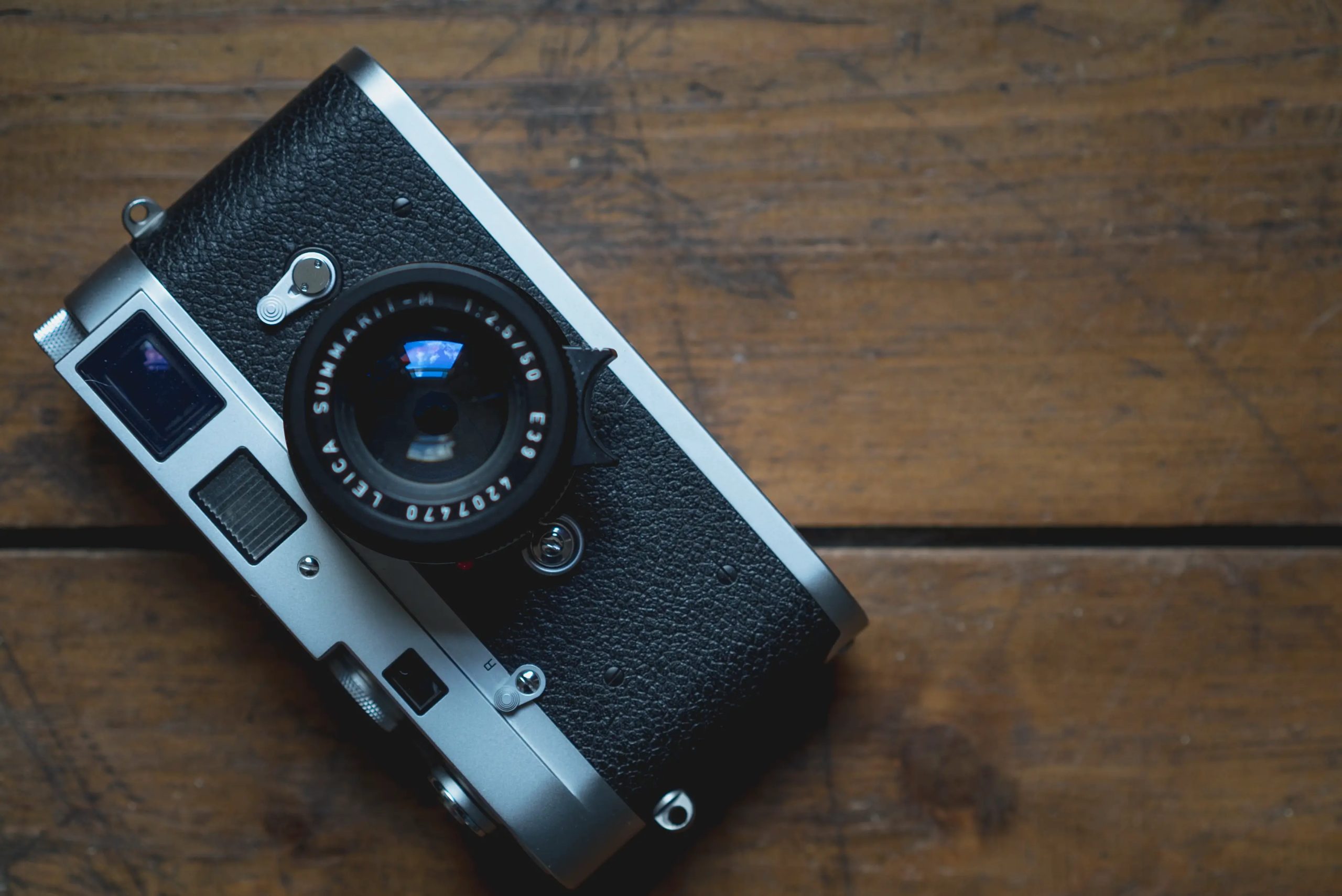
In hindsight I realise that it’s the comparisons I made in that bustling exhibition to my M3 and M7 that entirely qualify that sense of being underwhelmed. You see, I already own/have owned a Leica M3, M4-2, M4-P, M6 and Leica M7. I realise how spoiled that makes me sound, but actually being spoiled is exactly the problem. On face value, there is actually very little about the M-A to get excited about; it brings nothing particularly new to the table. It is essentially a combination of previous designs and refinements put together to create another new iteration of a concept that to a great extent has been proven time and time again.
So there is little point in the Leica M-A then? Well actually I think there is a little more to the Leica M-A than might initially meet the eye, both in terms of what it is as a functional object and what it represents as a product.
Since it’s almost entirely constructed of designs and features from previous cameras, it seems to me that to best understand the M-A is to compare it to these older siblings. Holding it up against the best and worst iterations of this 61 year old design is the best way to see it for what it is. I just hope – in my relatively limited experience – I can do these comparisons justice.
Comparing the Leica M-A to its siblings
In many ways, I think a comparison to an M3 is one of the safest comparisons that can be made. Outside of special editions every single Leica M body since the M3 has seen either cost saving or the use of parts that don’t, in my humble opinion, quite match the quality of the rest of the camera. I mentioned this opinion in my Leica M3 review, but I will just reiterate for the sake of clarity.
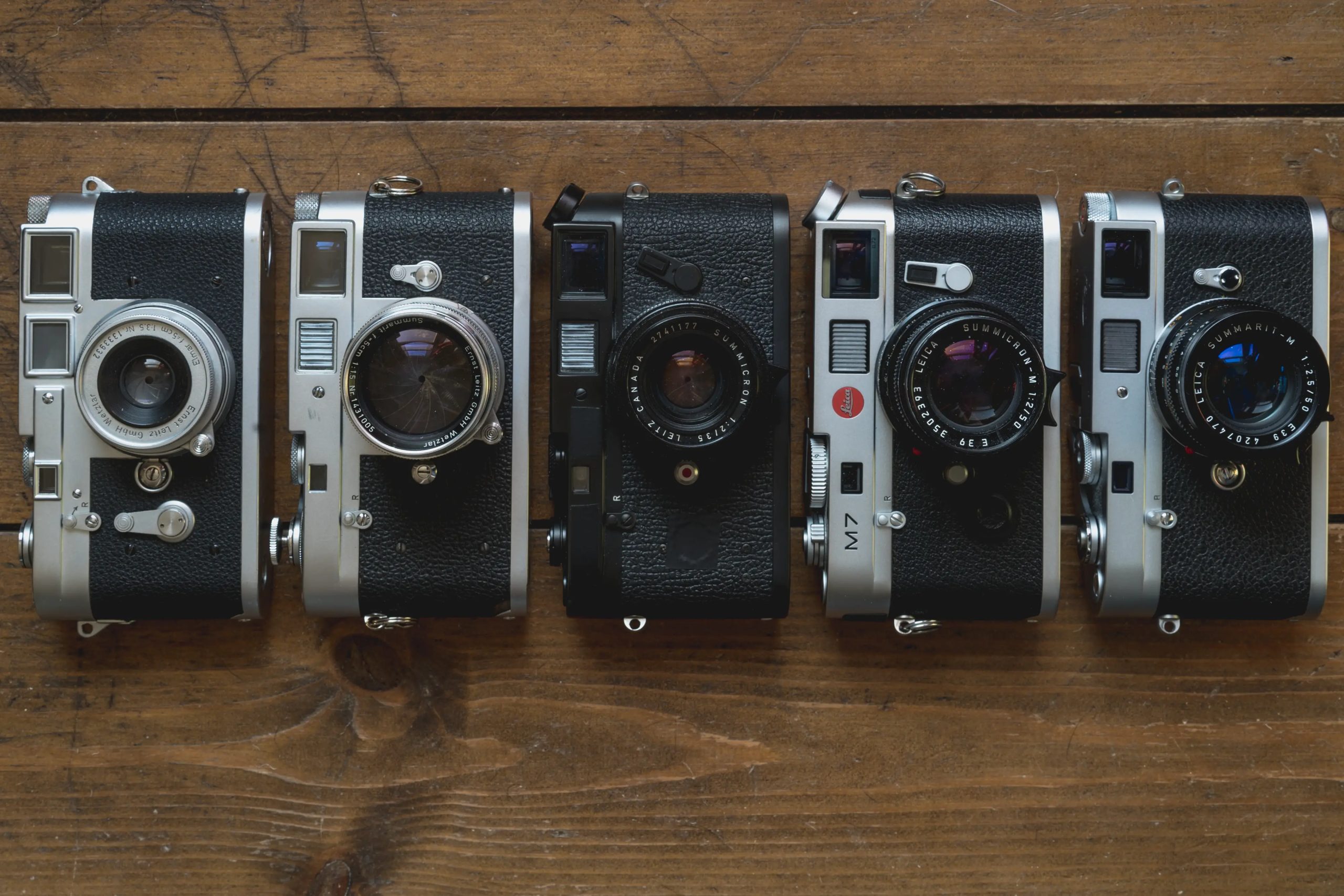
The M2 was built as a less expensive M3. The M4 was where plastic parts were introduced. The M5 was an attempt to do something special, but it fell on deaf ears, then when it damaged Leica so much, they had to resort to further cost saving measures. The resulting M4-2, though a great camera in its own right, was built more cheaply, and is rightly or wrongly regarded as the “cheap” Leica. The M4-P retained pretty much the same status. The M6 is an oddity in my mind, as despite having an seemingly untouchable status among many Leica shooters was even more cheaply constructed with zinc parts replacing brass parts of before. The early ones even had plastic internal parts. The M7 returned Leica to the use of brass, but certain parts of it really make me question what the hell Leica were thinking! That dial on the back – as I go on about in my M7 review – is an abomination that does nothing for the sense of overall quality. I forgive it, as I love the camera, but it irks me when I’m forced to use it. Even the MP, which supposedly stands for Mechanical Perfection includes the slightly crappy plastic battery cover and ISO selecting dial similar to those found on the back of M7 and M6 that came before.
The Leica M-A on the other hand feels like it shares the design philosophy of M3, a philosophy of absolutely no cost cutting measures at all. Cast your eye over the back of the camera and you won’t see a plastic bit of crap dial, you will see an ISO dial that’s made of metal and is in fact reminiscent of the one first seen on the M3; it’s just a little more modern looking in its design.
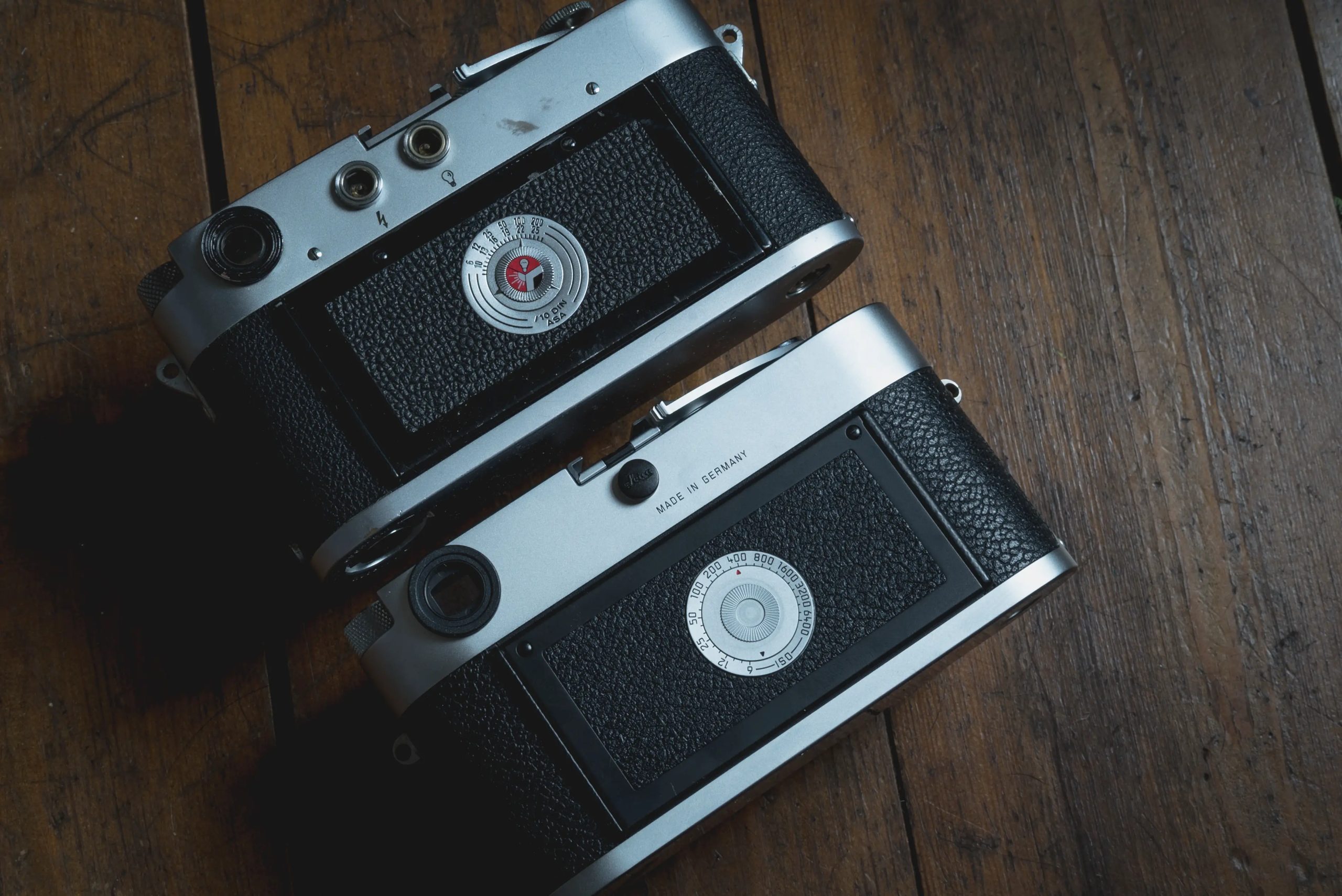
But, unless I’m mistaken, this ISO dial is pretty much the only part that hasn’t been seen on another Leica that came before it. Every other part of the camera can be identified as originating on one or another of the cameras in the Leica M-A’s 60 year family tree.
How the Leica M-A got its spots
To start at the beginning, there are several features of the Leica M-A that were first seen on the M3. The all metal film advance, the knurled metal rewind nob with the two little red dots on top (seen in the later M3s) and the metal surround to the lens release button. The shutter speed dial is small and is notched to allow the attachment of a coupled light meter.
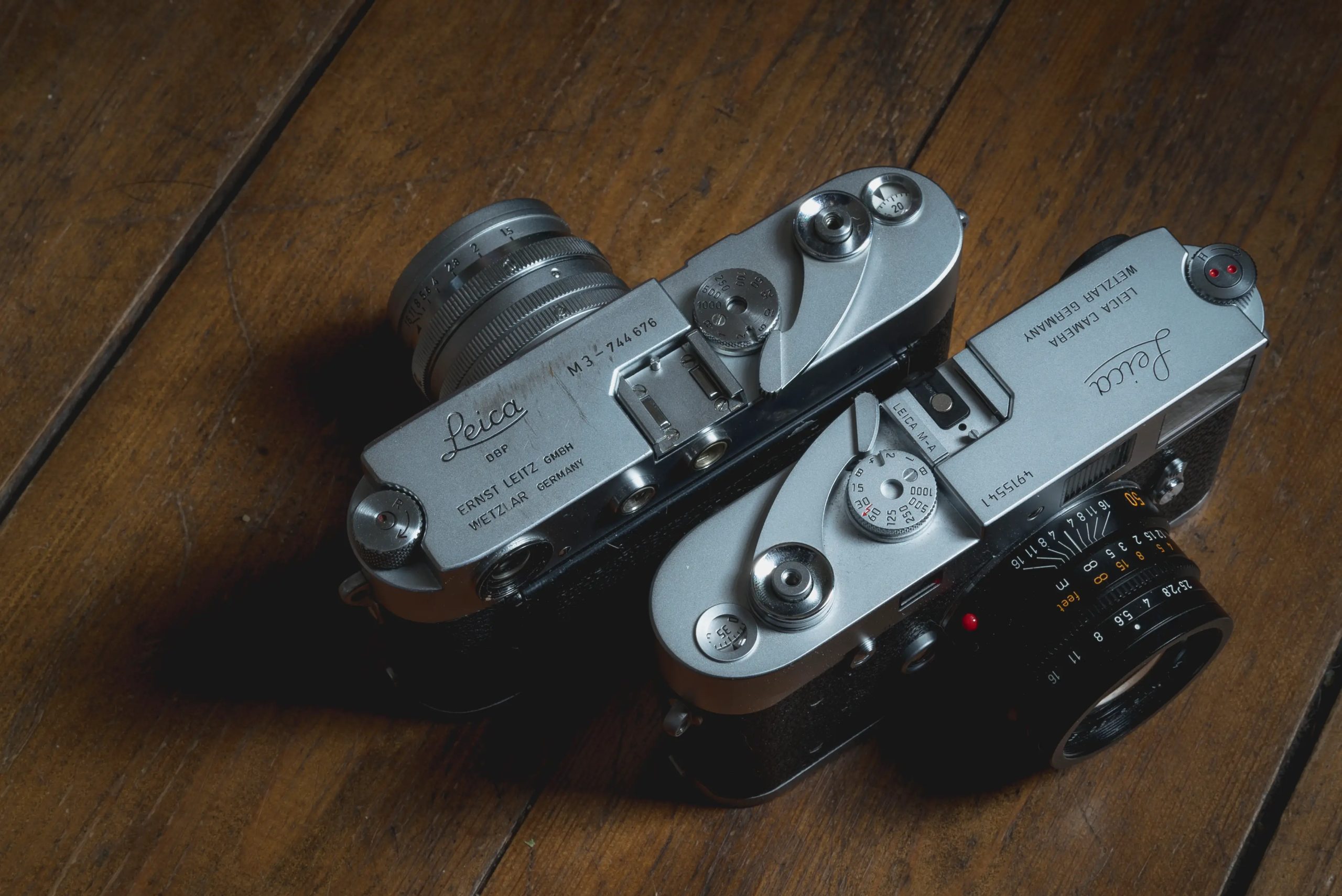
Its shot counter is also enclosed in the body and viewed through a little hole, a feature that was dropped in favour of an external manually set shot counter for cost savings sake on the subsequent M2.
Like the M2 though it does have a .72x magnification finder with a Fresnel frame line illumination window. In fact if you hold it up next to the M2 it looks pretty much the same from the front. The viewfinder window frame is flush to the front and it lacks the self timer in the same way the more common M2s do.
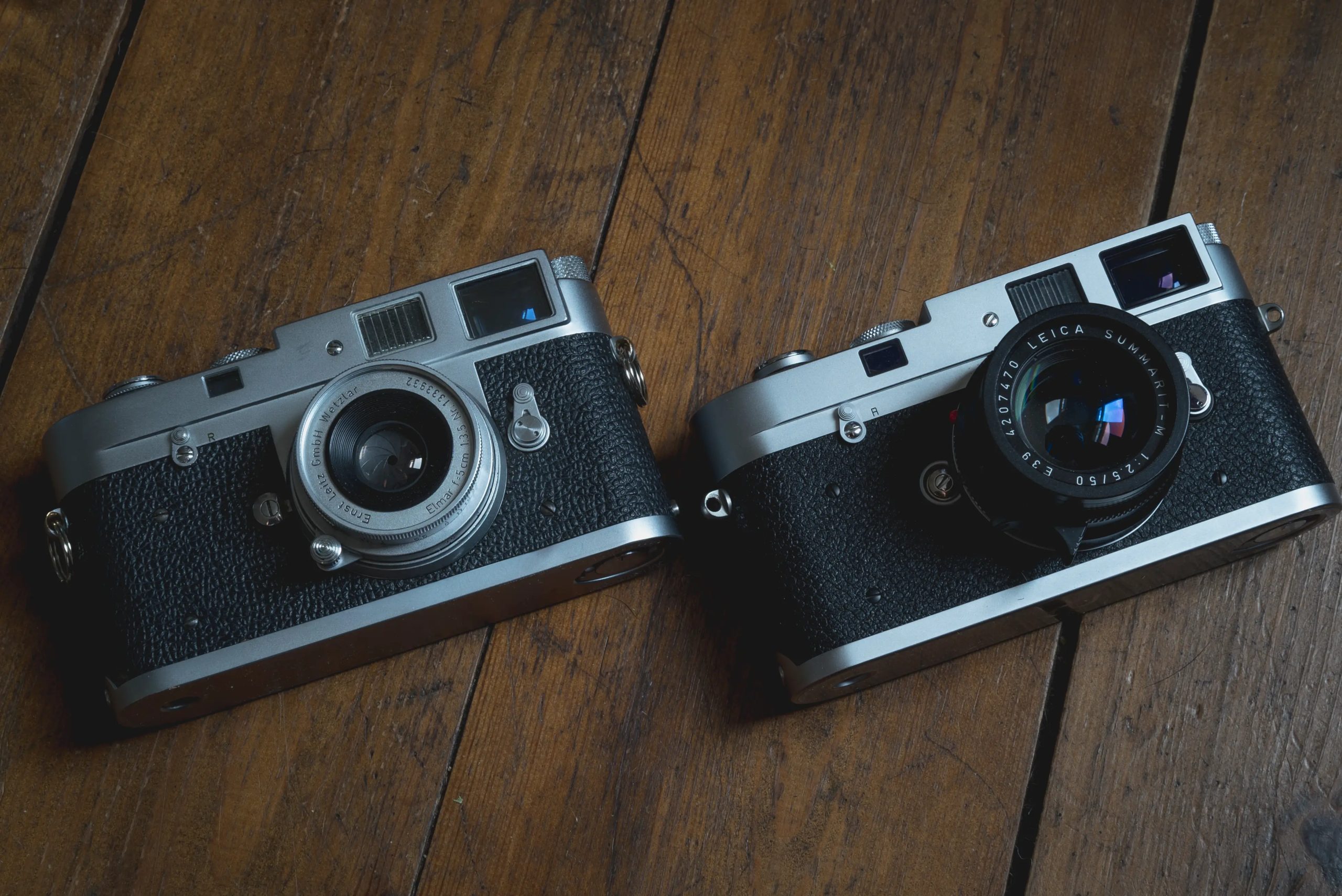
The M4 that followed the M2 returned the shot counter to the inside of the top plate a la M3, but it also included the first plastic parts. But, as I say, none of these plastic pasts are inherited by the M-A. There is though one important thing the Leica M-A does inherit from the M4, and that is the quick loading mechanism. This might be an issue for some, but in my view it is a a big step up from the early separate more fiddly take up spool.
It terms of inherited external or easily visible parts, it then skips a couple of generations past the M5 and M4-2 to the M4-P. I’m going to talk a little more about the M4-P for different reasons in a moment, but since I am identifying the M-A’s heritage it’s worth pointing out here that the 6 frame line viewfinder configuration the Leica M-A originated with the M4-P.
After that, things become a little less obvious. The viewfinder glass is coated, which is something I think that originated in the M6, maybe M7? Though I suspect the viewfinder and indeed the coating as it currently stands is actually shared with the MP. The MP viewfinder was also better sealed off to the outside world, and doesn’t let dust in to the same extent some previous finders did (my early M7 included). It also has the condenser in the rangefinder mechanism that was in the original M’s, removed on the M4-2 and then returned on the MP. Don’t ask me what that is though, I don’t have a clue, I think it is supposed to make the rangefinder patch brighter or clearer? Another thing I don’t really have a clue about is the internal construction… I’m not one for taking these things apart. It’s said to be the same as the MP, which I imagine is fairly similar to the early cameras, what with it being fully mechanical. I suspect though that it shares internal construction method with the later M cameras that started with the M4-2. Since my mate Alex’s M4-P remains to this day one of the smoothest feeling Leica’s I’ve used, I’m not sure that matters much? Others would no doubt argue with me on that point?
So it’s just a mush of old bits…?
It could be (and in fact is in many places out there in internet-land) argued that this lack of invention, lack of anything new (apart from the ISO dial) makes for a pointless camera. Why not just buy an older M for a fraction on the price and have it serviced? There is after all no reason a serviced older M wouldn’t be as good or as long lasting. As I said before, it’s definitely this lack of anything new that might lead to a sense of being underwhelmed. Why would anyone get all that excited about something they have basically seen before on various iterations of a design that has been rehashed yet again. Well, personally I think some of the problem is down to human nature.
We are, as human beings, strongly programmed to expect something bigger, better, faster etc from a new iteration of something, especially within the world of camera manufacture. Because of this, when we are faced with the sort of level of subtle improvement the Leica M-A brings, I think it’s quite natural that we can be underwhelmed. But, if you turn the idea that this camera is just a bunch of bits we have seen before on its head and say, actually, this camera is a cherry picking of all of the best bits we have seen before, then that sense of being underwhelmed might also get turned on its head. In fact, if you agree, subjectively speaking, that this camera is a mush off all of the best bits that came before then it stops being a pointless thing, and actually it could be said to make ownership of any other Leica M film camera underwhelming. I shall get to whether or not I agree with this personally in a moment.
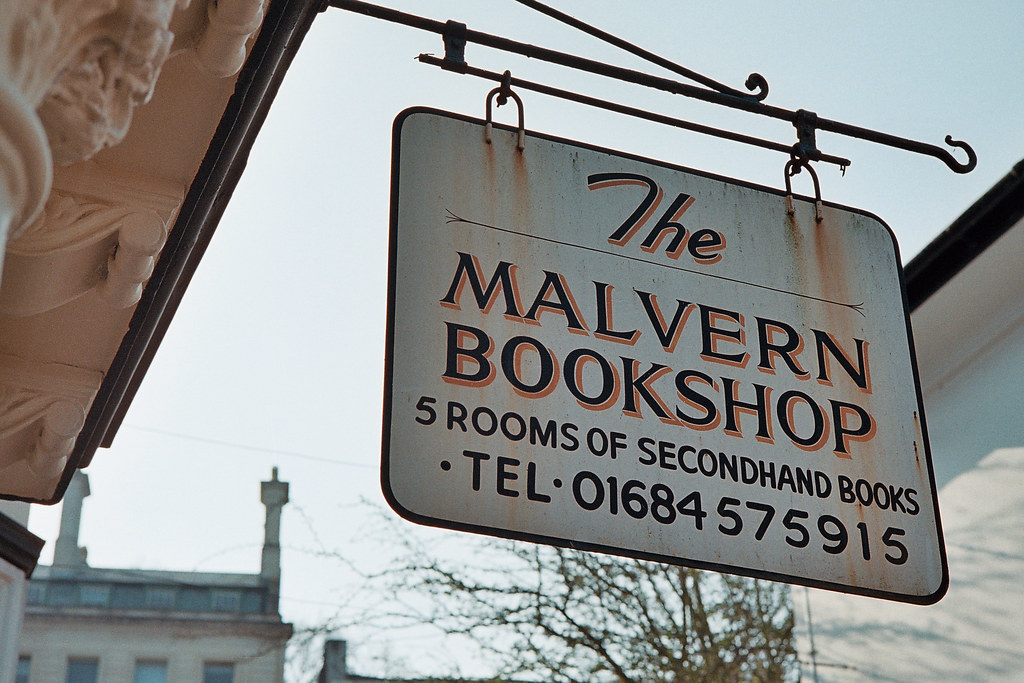
What I think the M-A means for Leica
I had to have a chuckle at the marketing babble on the Leica website. It refers to the Leica M-A as slimmer than a digital, and the design as being reminiscent of the Monocrom. I suppose, you can’t argue with the facts, but as someone who’s never owned a digital Leica, I think of them as fatter than the film cameras not the other way round. It’s the same size as my M3 and M4-P, with the M7 being a touch taller. Excluding the M5, they have been pretty much the same size since the M3 was launched 61 years ago, so to refer to them as being slimmer than a digital just seems a bit odd. Of course, I’m aware of the reality that the market for digitals must dwarf that of the film cameras, so in Leica’s eyes perhaps far more potential customers are current digital owners rather than film camera owners of old?
This is actually something that seems reflected in some people’s response to the Leica M-A in the film photography community. As I’ve already paraphrased, some Leica film shooters have asked why Leica would release this camera. Who is going to buy it? Many of them claim things like “I’d much rather spend that sort of money on a black paint M4”. I wonder if Leica are aware of this, and so choose to market their new film camera more toward the digital new-camera buyers out there? They must be aware of a slow but steady babbling resurgence of film photography, maybe they feel that they can tap into that by tempting some of their dedicated digital-shooters to film.
Regardless of this, to my mind at least, simply by the merit of making the thing they are definitely showing an awareness of the film shooting community, and frankly, whatever you might think of the M-A, I think they should be applauded for it. Though I should add, it does make for a strange world where, unless I’m mistaken, the only two brands that make, or at very least continue to release new 35mm compact are Leica and Lomography…!
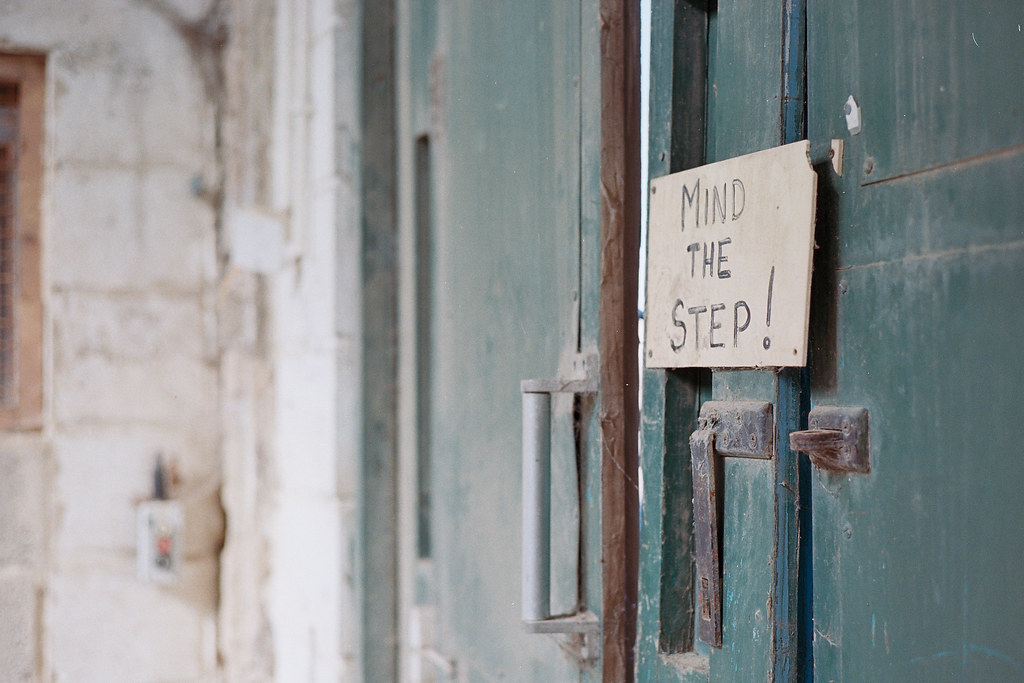
The Leica M-A vs. the Leica M4-P
After all my previous comparison and talk of cherry picking of the highest quality of Leica parts, you might be wondering why on earth am I drawing on the M4-P – one of the “cheap” Leicas – to make more of a comparison? Well, to start with, I own one, so it’s an easy camera to compare it to. But actually there is a greater point to this particular comparison.
If you have read my review of the M4-P you will realise that I have quite the soft spot for it. There’s something about its somehow industrial-feeling simplicity that makes it feel more like a photographic tool than “Leica”. I mention this, as there is an element of this simplicity in both the look and the feel of the Leica M-A. Especially the black chrome one.
The funny thing with the M4-P is that for it to feel like a tool, it feels – to me at least – as though all the Leica badges need to be hidden. As mentioned in my M4-P review I think its design somehow lacks confidence on Leica’s part. By branding the hell out of it, by emblazoning that red dot large and proud across the front, having “Leica” big and white on the front of the top plate, “Leitz” on the top and the brand name once again across the back of the camera, it could struggle to remind you any more of its maker. To me this makes the camera feel like its design somehow lacked the confidence to just exist as a tool; it had to also be a Leica. By comparison the M-A – the black one at least – almost entirely lacks branding.
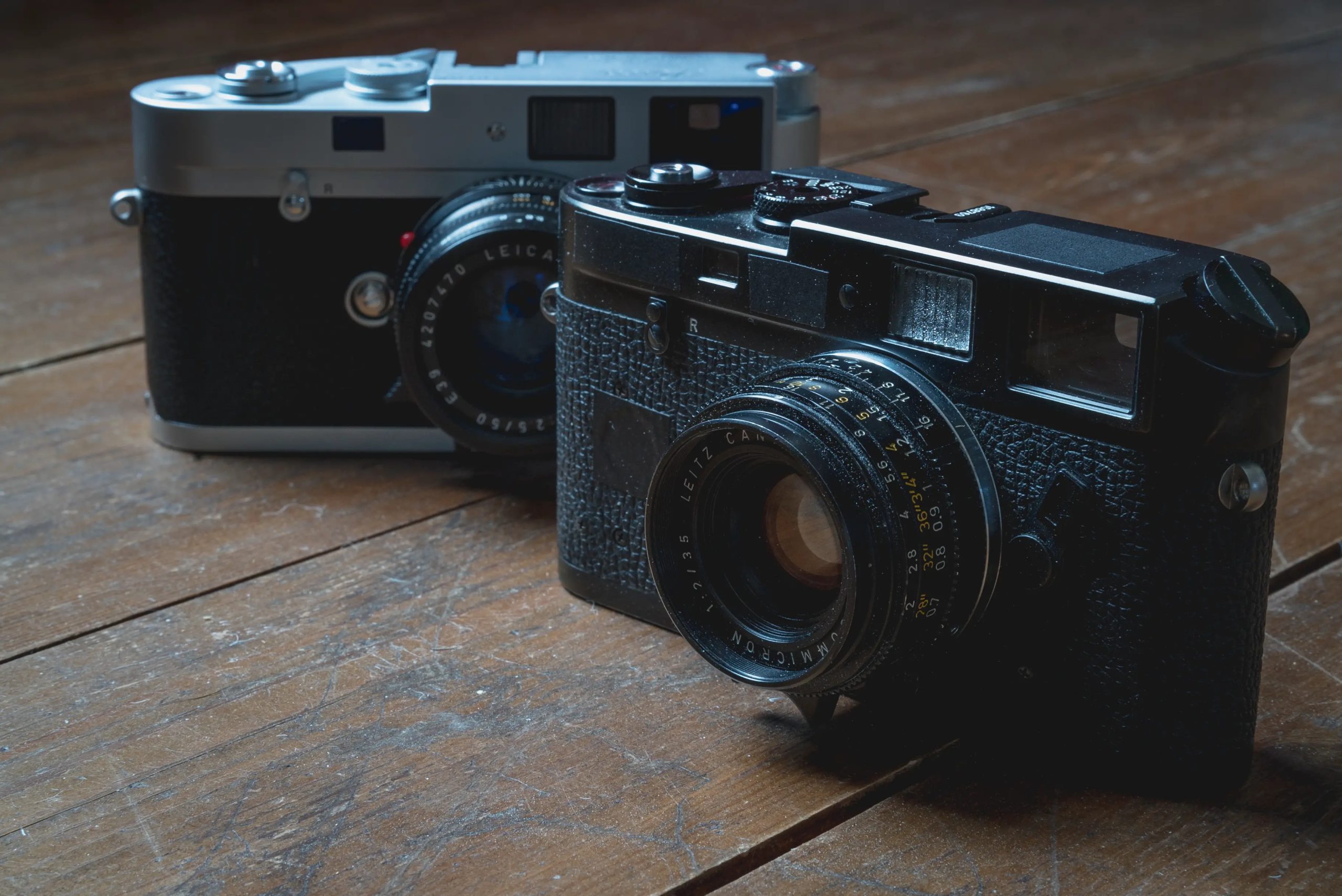
Now, I’ll admit here that I’m very possibly thinking about this too much, but holding these two cameras side by side it feels as though they represent the confidence levels of the company in the product they were producing at the point in time they were/are producing it. The M4-P came from a company that was just beginning to find its feet after a difficult time in its history. They couldn’t quite muster the uber-high standards of construction, so relying on the Leica name was the order of the day. By comparison, the Leica M-A oozes self confidence, there is no need to rely on the name, the brand is evident in the shape of the camera alone. There are very few products that can rely just on their physical appearance to portray their brand – the Leica is one that manages it effortlessly. Leica having confidence to not include branding on the black version, to me emphasises a confidence in the solidity of the brand that they perhaps didn’t have in the era of the M4-P. Of course, I don’t suppose they are so reliant on the M-A as a large part of their bid to keep the company going in the same way as they were in the era of the M4-P… and it’s certainly not like they have a big R&D or tooling bill pay off with its sales. They must have had the kit needed to make this camera knocking about for years!
Now Leica have 60 years of experience and the tooling to make it, the crutch of the vast array of digitals and special edition cameras and an arguably much more stable brand, the Leica M-A is free to just be what it should be and not what it needs to be for the sake of marketing purposes. Ironically of course, this makes it a wonderfully marketable product. It certainly makes a mockery of Nikon’s “pure photography” marketing of the Df a few years back…
Of course the Leica M-A does retain some of the luxury, there is even almost a slight arrogance in features like the knurled metal rewinding knob which we all know isn’t as practical as the crank on most of the post M4 cameras, but is really there just because it looks prettier. But like the M4-P, there is no shinny glossy black paint finish, just chrome. Whilst I have no doubt that Leica will eventually introduce (or at very least do a run of) a black paint version, for the time being the choice is only between a simple chrome or black chrome finish. The unbranded matt black chrome being possibly the most understated finish available for any Leica film camera to date. The silver chrome gives a little extra nod to Leicas of old with its “Leica” in script on the top of the camera, but even then it doesn’t feel as though it is shouting its brand.
This for me all adds up to a product that feels exactly what I think a Leica should feel like. Yes there is an element of luxury, a sense of quality, or perhaps even perfection of build, but along side this comes something else, something I think is almost more evident than anything else in the Leica M-A, and that’s a sense of function. It is just what it is, a very beautifully made, simple functioning camera – like the M4-P before it – the M-A feels like a “pure” photographic tool.
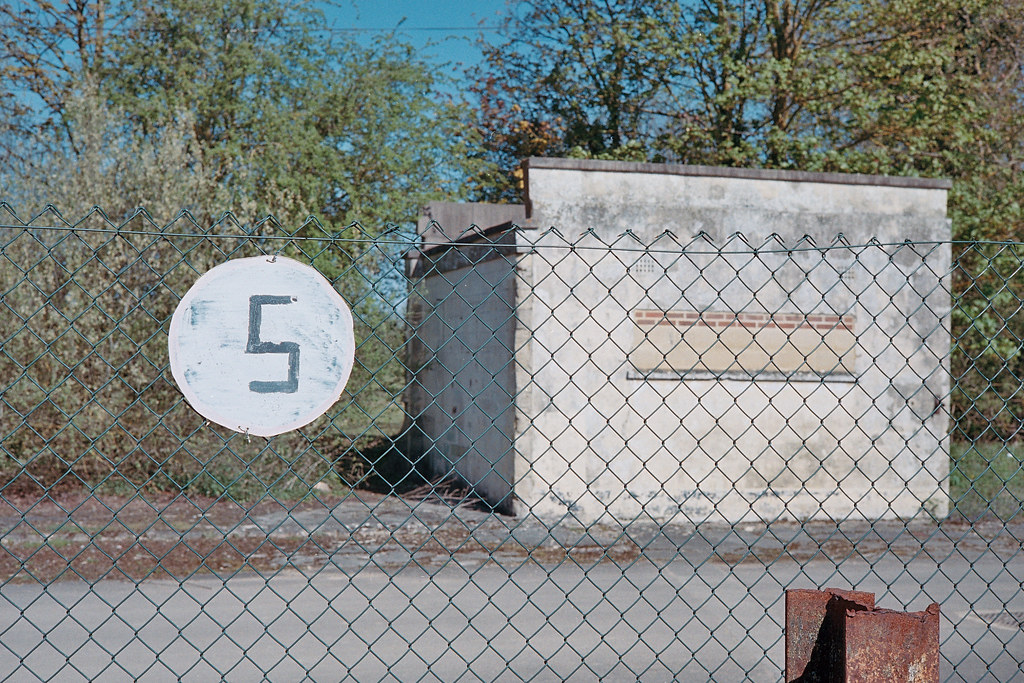
So what is it like to use – the Leica M-A review
So after all these musings about what precisely the Leica M-A is, the question still remains as to what it’s like to use. Well since I am clearly a fan of Leicas, as I’m sure you can imagine my opinion is going to be pretty positive? It is of course a wonderful camera to use. It’s smooth in its mechanical function, the viewfinder is probably the brightest and the rangefinder the clearest of any Leica I’ve used to date. Under close inspection the fit and finish seems better too. The rewind knob doesn’t wobble when extended in the way it does on my M3, and the tension in the rewind is a lot less than that in the older knob-rewind Leicas I’ve used. The leather grip fits perfectly and feels softer and more comfortable to hold than the old vulcanite grips. And more than anything else, it just feels new!
It also fulfils my preferences in terms of function and form. I prefer the slightly less functional but infinitely more pretty knob rewind. I prefer the solid metal film advance (despite the fact that they jab me in the waist from time to time), I prefer the quick loading mechanism, and favour having all 6 frame lines available and a .72x finder… and if I haven’t yet made it clear enough, I most certainty prefer the metal ISO dial on the back over and above the plastic monstrosity found on various other Leicas. Really though, beyond that, to a great extent, feels no different to using the M3, M4-P or the M2 I’ve recently had on loan from a mate.
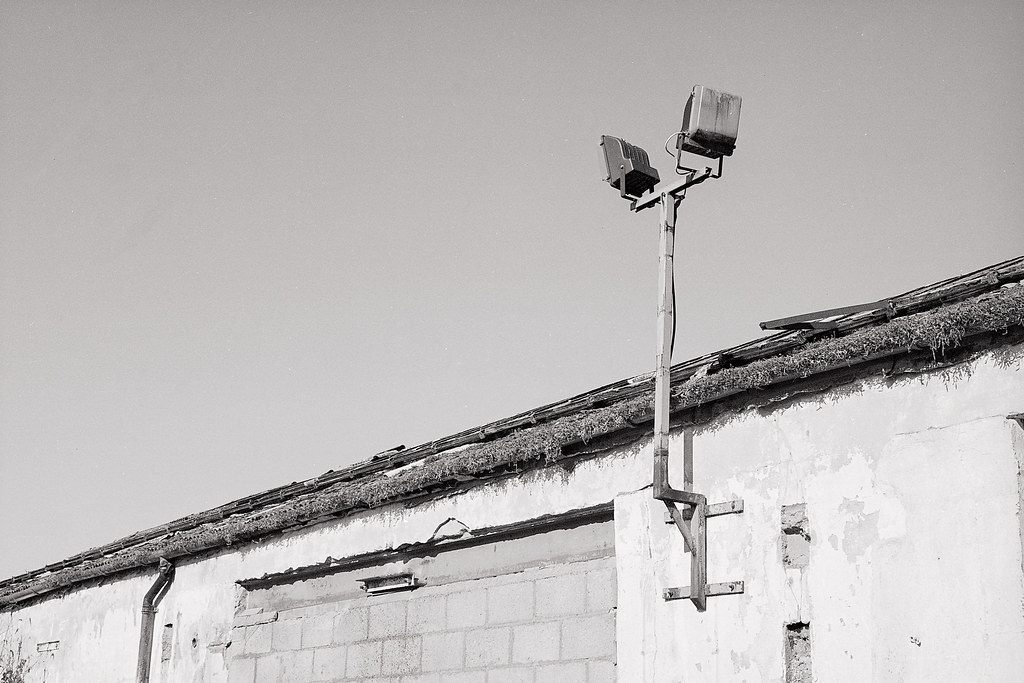
So what does the Leica M-A means for me?
Outside of it crappy plastic bits, the Leica M7 – as I have mentioned many times on the blog – really is the ideal camera for me. For a larger percentage of circumstances I just prefer a built in meter and aperture priority mode. At least, this is the mantra I’ve found myself repeating… Recently, honestly, I’ve felt otherwise.
Shooting with an M3, M2 and Leica M-A in quick succession often without really relying on a light meter that much has been an absolute joy. But then it’s also been sunny more recently, and shooting meterless in the sunshine is a lot easier than some of the situations within which I think the M7 shines. This is something I’ve been reminding myself of quite a bit whilst shooting with the Leica M-A. It’s been a joy to shoot with, but I’ve felt it important to focus myself on not getting this joy confused with the process and joys of just shooting a meterless camera. After all, I can shoot without a meter or with the help of a hand held meter with many other cameras, including the cameras I’ve been shooting recently. Moreover this also includes my Leica M4-P, which in terms of function, to all intents and purposes, is the same camera and worth around 1/5th of what the M-A would cost me… and I’ve already got one!
With that in mind, why on earth would I buy a Leica M-A? Well that is of course the question I have been trying to answer for myself since I first started writing this post. And, if this post could be considered a Leica M-A review, I guess it’s possibly one of the questions you the reader might be interested to know the answer to as well? Well, before I answer that question, the question I feel I need to answer first is one I posed earlier in the post; the question of whether or not I think it supersedes all the manual Leicas that preceded it. Or if, because of what came before, it just didn’t need to be made?
For me, the Leica M-A did need to be made. Whilst I don’t think it is a progression from what has come before, I definitely think it is a refinement. Through a combination established designs and quite small refinements, it brings little that is new to the table really. But actually, to my mind that’s precisely its appeal, and indeed a big part of its justification for existence. No big changes to the design were needed, so what Leica did instead was just to completely perfect it. It might have taken them 60 years, but in the end, to me at least, it feels like this is the completion of the project; the last required iteration in the family line.
Ultimately, what I think the Leica M-A represents is the 60 years of a camera’s history with a design that pays homage and is sympathetic to all that came before. A camera that represents the best achievements in a 60 year long industrial design process. A camera that is almost a perfect representation of the embodiment of everything that inspired a design that continues to provide the right haptic and mental experience for users of both film and digital. Yet it does all of these things with very little superfluous gloss, and because of that it I feel it manages to hold on to its status as a photographic tool. Something that the likes of the special edition pre-worn Leicas somehow profoundly seem to lack.
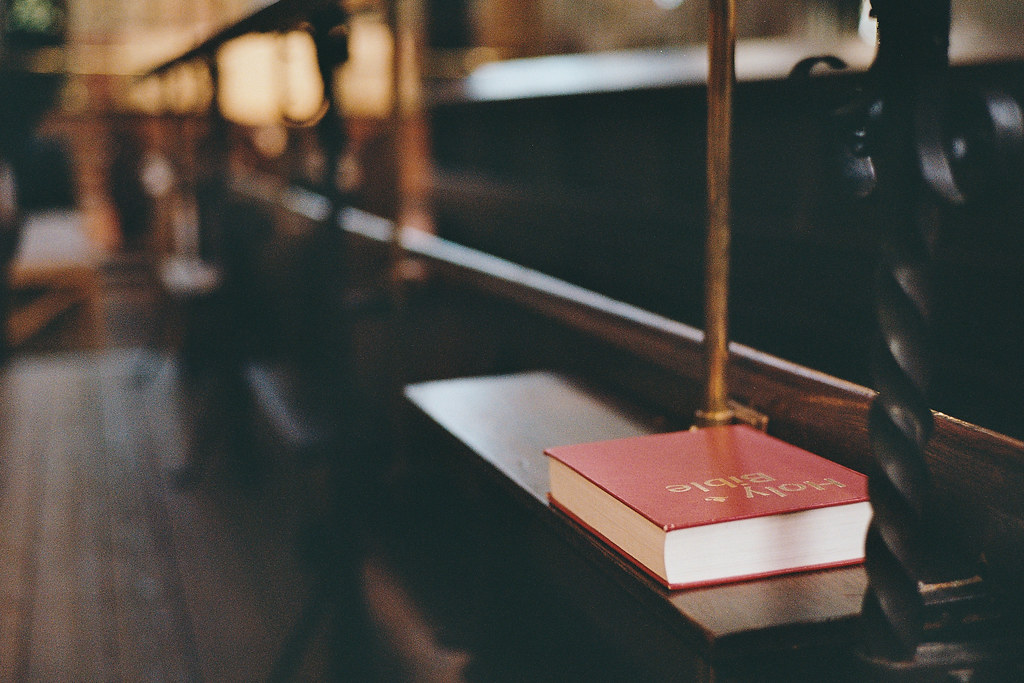
The beautiful irony of all this is that on first glance, on first interaction, it might seem underwhelming. It did to me, it did to that chap on the forum I mentioned at the beginning and it has done to the couple of Leica owning mates of mine I’ve asked. After all, what is there really to get excited about? Well if you disagree with my comments above and are happy with your M2 (or whichever you own) then nothing I suppose… But if like me you can see something more, then actually I think there is quite a lot to be excited about.
If nothing else, one thing that can’t be denied is that it’s a manual Leica for my generation. It gives me the opportunity, should I choose to take it, to own a new fully manual Leica from new, to be the first person to use it and appreciate it. This is something that no second hand Leica can give.
So will I be buying one? Well yes I think I will. But whilst the question of “if” is answered, the question of “when” remains, and this is something I don’t yet know the answer to. Thankfully I don’t think I need to worry about it yet either. It’s not as if Leica are going to bring out the bigger, better, faster version or that I feel I’m waiting for them to bring anything else out – A feeling I still get when I buy digital cameras for work. Equally, it’s not as if they are going to stop making this one any time soon… at least I hope not. I have therefore the time to sit back and appreciate the Leicas I currently own. I have some time to work out whether or not I still feel so strongly about the way the M7 works for me, or if after some more time with my M3 I am more happy with a fully manual camera.
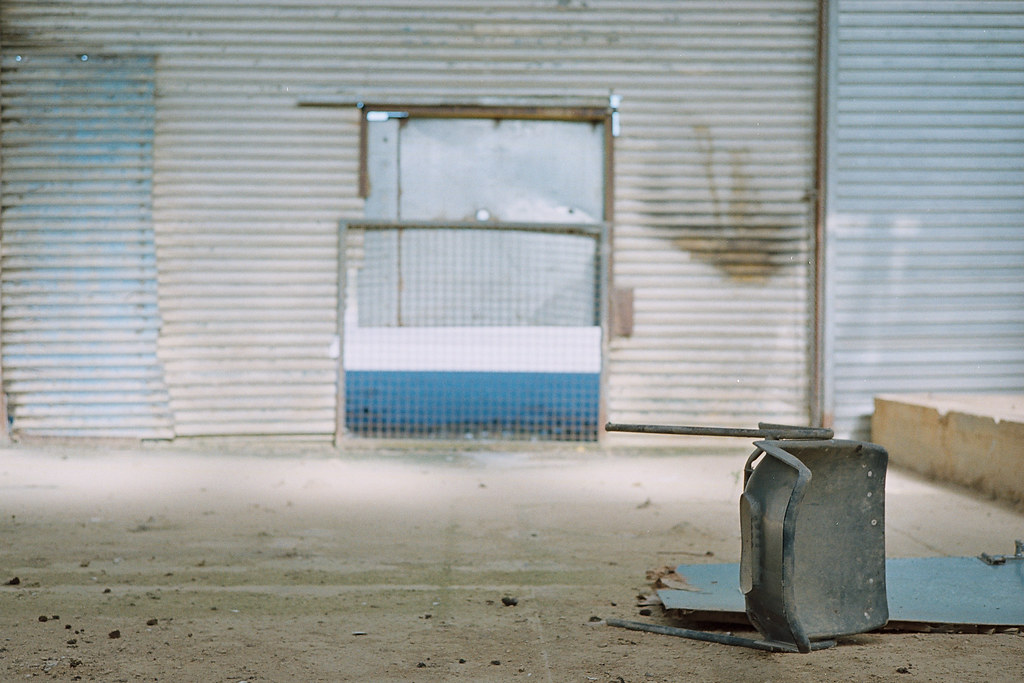
Of course I might become impetuous and buy one sooner, but either way, it doesn’t matter because this camera – unlike every other on the market – stands as a unique product amongst its peers. It is completely outside of the usual linearity of advancement upon advancement in camera production. If I buy one now, tomorrow or in five years, it is very unlikely to change. The Leica M-A is now what it will always be, the perfect fully manual Leica rangefinder camera.
Cheers for reading
Hamish
Links and more reading:
The rest of my photos taken with the Leica M-A on Flickr
Review of the Leica M-A – Ray Larose
Applied Relativity: The Leica M-A – Ultra Something
Share this post:
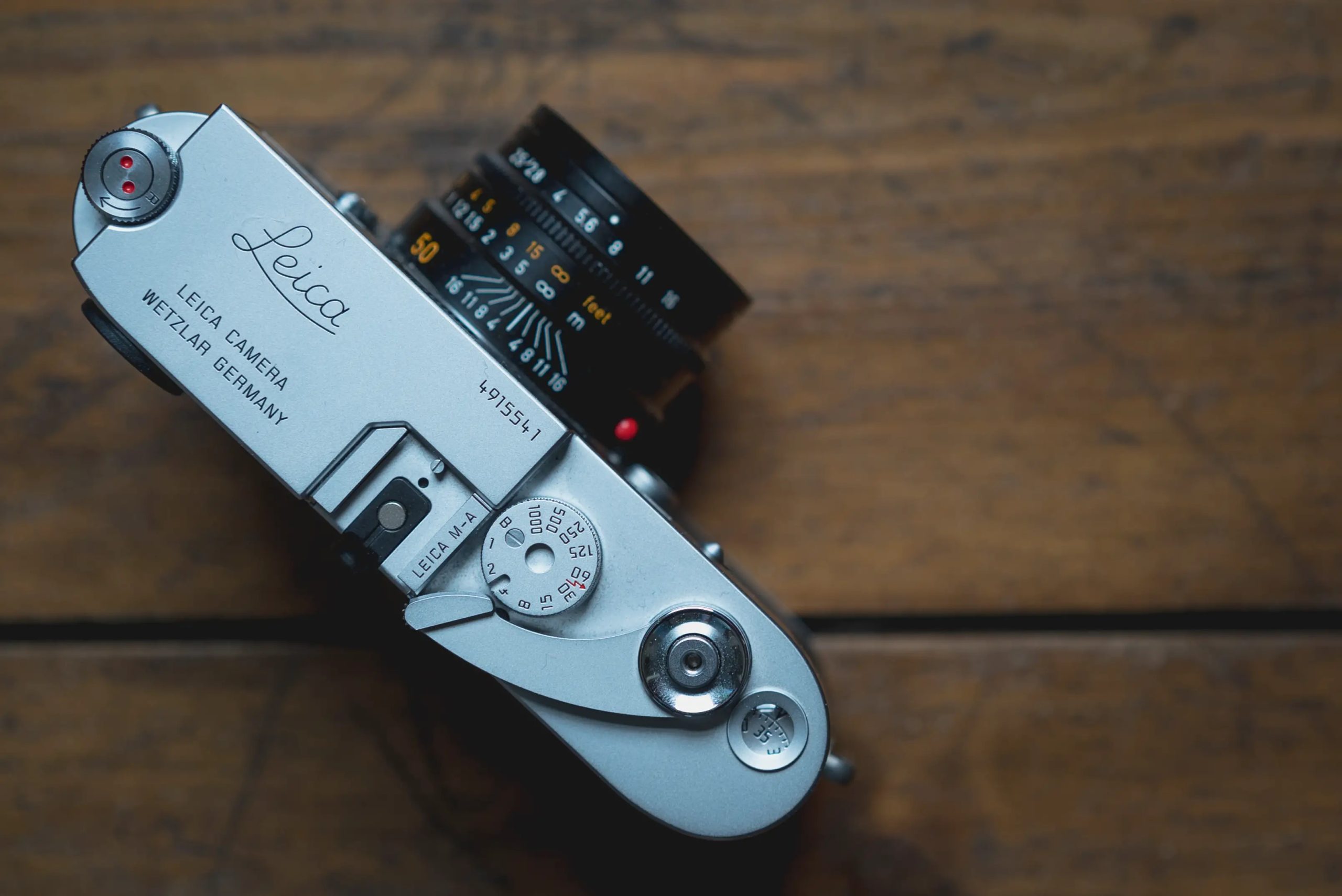








Comments
Ray on Leica M-A Review – The Perfect Rangefinder?
Comment posted: 20/04/2015
Ray
Comment posted: 20/04/2015
Comment posted: 20/04/2015
Kevin Shelley on Leica M-A Review – The Perfect Rangefinder?
Comment posted: 20/04/2015
Thanks for the excellent article. It's always refreshing to read a review written by someone who understands and appreciates the Leica brand for what it is (including) its shortfalls, rather than endless remarks about how it's 'not as good as a 5D mk3 etc . . .
I would say however that the M-A says M2 to me - but then I would say that as the M2 is 'the one' for me. :)
Thanks again,
Kev
Comment posted: 20/04/2015
Comment posted: 20/04/2015
Comment posted: 20/04/2015
Daniel on Leica M-A Review – The Perfect Rangefinder?
Comment posted: 20/04/2015
Comment posted: 20/04/2015
Chris on Leica M-A Review – The Perfect Rangefinder?
Comment posted: 21/04/2015
Comment posted: 21/04/2015
The Leica M-A – 35mmc | Hamish Gill on Leica M-A Review – The Perfect Rangefinder?
Comment posted: 21/04/2015
Ess Vaun on Leica M-A Review – The Perfect Rangefinder?
Comment posted: 22/04/2015
I saw an earlier comment & think if you've got one in your hands, are taking shots & have the gumption to put your thoughts out there you're more entitled than most to do so.
For mine, it sounds great, but with a superb M3 in my hands I'd have to say, no compelling reason to change, given the M3 will outlast me. I agree with your suspicion, this may well be aimed at the well heeled digital owner. If I had the money & no M3, that tune may well change.
All the best, look forward to seeing your next missive!
Comment posted: 22/04/2015
foto2021 on Leica M-A Review – The Perfect Rangefinder?
Comment posted: 10/05/2015
The 35mm film Leica I would really like to see would offer controls consistent with the M8, M9, M(240) etc., and have an electronic shutter with a reliable top speed of 1/4000 or even 1/8000 sec. Why did Leica revert to a shutter speed dial not used since the M6 Classic? All Leica M bodies since 1998 have had a larger diameter dial which rotates the other way. Anyone with a digital M will find the A-A's handling very strange indeed.
Fifteen years into the twenty-first century we should not be struggling with a cloth shutter that cannot reliably achieve 1/1000 sec. The Nikon F801 (N8008) achieved 1/8000 sec very reliably, and that camera was introduced over a quarter of a century ago. If you want to get the best out of your fast Leica glass without using ND filters, you need something much faster than the average 1/700 sec that is about the best Leica's cloth shutters can reliably deliver.
Comment posted: 10/05/2015
Comment posted: 10/05/2015
Comment posted: 10/05/2015
Comment posted: 10/05/2015
Comment posted: 10/05/2015
Comment posted: 10/05/2015
Comment posted: 10/05/2015
Comment posted: 10/05/2015
Comment posted: 10/05/2015
First Roll with my Leica M-A - Lndwlk 3.0 - 35mmc on Leica M-A Review – The Perfect Rangefinder?
Comment posted: 11/05/2015
Andrew on Leica M-A Review – The Perfect Rangefinder?
Comment posted: 18/05/2015
I shoot a lot more digital than film, so the problem isn't in how much I like or want the M-A, but just in justifying the cost.
Comment posted: 18/05/2015
Bob Owen on Leica M-A Review – The Perfect Rangefinder?
Comment posted: 19/05/2015
I learnt long ago that the you don't have to justify the camera you use to anyone, as long as it makes you happy. Enjoyment is the only currency that matters.
Smashing blog. Cheers
Comment posted: 19/05/2015
John Ricard on Leica M-A Review – The Perfect Rangefinder?
Comment posted: 03/07/2015
Comment posted: 03/07/2015
Bobbi on Leica M-A Review – The Perfect Rangefinder?
Comment posted: 23/07/2015
P.S. to the troll: I'll take a quiet cloth 1/700 to a tectonic titanium 1/1000 ANY day.
Comment posted: 23/07/2015
Bobbi on Leica M-A Review – The Perfect Rangefinder?
Comment posted: 17/08/2015
Comment posted: 17/08/2015
David Murray on Leica M-A Review – The Perfect Rangefinder?
Comment posted: 28/08/2015
I like the M4-P bodies and tend to use the Leicameter MR4 atop the one in use. Film runs out, just exchange lens and carry on shooting. I don't think there is anything cheap about the M4-P, after all, in 1980 it was aimed at the professionals who had started to use the 28mm Len in preference to the 35.
Comment posted: 28/08/2015
Comment posted: 28/08/2015
Comment posted: 28/08/2015
James Lau on Leica M-A Review – The Perfect Rangefinder?
Comment posted: 10/09/2015
thanks for your great details review on the M-A , and also had to hand on it, but is it the M-P (film) is a better choice ? or even a pre-own M4/ M6 for the price to pay off?
Regards
James Lau
Comment posted: 10/09/2015
Tony on Leica M-A Review – The Perfect Rangefinder?
Comment posted: 10/09/2015
I really enjoy reading other people's take on this camera. For me, I'm getting off the digital camera treadmill and back to a simpler and more satisfying photography that I began many decades ago. That was the time when photos were printed on real photographic paper, there were negatives, there was the anticipation and excitement of waiting for your photos to come back from the lab, the smell of a fresh roll of film out of the package, the act of loading a camera, of actually having to think about each photo before pressing the shutter. I used to develop and print my own black-and-white photos when I was at high school, and I may get back into that again. The art of photography and the zen-like moments are what I miss and didn't get too often from digital because it's so mundane: let the camera focus, let the camera choose the speed and aperture or change the ISO. Where is the challenge? Where is the satisfaction, or even the fun?
I was about to get the new Sony A7R II, which seems like a great digital camera, but then the usual digital kinds of nonsense came up. It doesn't have 14-bit RAW...does that matter? The images may be subject to moiré (on a $3200 body, no less). In 2 years there will be another, better, bells-and-whistles box for another few thousand dollars that people will salivate over. I stepped back and thought about what I really wanted, and I came to the conclusion that what I really wanted was something simpler, much simpler, more honest (none of the Velvia simulation or Portra simulation or fake B&W, or "toy camera" simulations. What I wanted was to not spend hours in "post-production" in Lightroom or (gasp) Photoshop. I'm done with that.
Of course, I don't make my living from taking photographs. I don't have to send images to an editor by 10 a.m. tomorrow, or sell my capabilities to an engaged couple to get their wedding gig. I just take photographs for the pleasure of the creative process from start to finish. That's why I'm getting a Leica M-A. I will never have to upgrade it. I will never have to worry about the electronics dying (as has happened to at least 2 digital cameras I owned) or not being able to find a replacement battery in years to come. As for the point that some people raise about getting a great used M3 or M6, that's not what I want. I want a brand new, fresh out the box camera that no one else will have used before me. I don't buy used cars, and I don't want a used camera, even if it has years of life still in it. Just a personal preference.
I will keep my Fujifilm X100S, which is a little wonder and great for point-and-shoot at parties or family get-togethers. But when I want to take real photographs, when I want to get into that creative zone, it's going to be on this Leica M-A bare bones, incredible photographic instrument which has nothing to get in the way of what I would like to do. That's the point I've come to in my decades-long love of taking photographs. It feels good.
Comment posted: 10/09/2015
Comment posted: 10/09/2015
Comment posted: 10/09/2015
Comment posted: 10/09/2015
Comment posted: 10/09/2015
Jens Webster on Leica M-A Review – The Perfect Rangefinder?
Comment posted: 20/10/2015
Thanks for your great review!
The M-A it`s a fantastic "machine" I love It..
regards
Jens
Ken Raymond on Leica M-A Review – The Perfect Rangefinder?
Comment posted: 03/12/2015
Comment posted: 03/12/2015
Akarapol Lenavat on Leica M-A Review – The Perfect Rangefinder?
Comment posted: 13/04/2016
Comment posted: 13/04/2016
TomL on Leica M-A Review – The Perfect Rangefinder?
Comment posted: 04/08/2016
(Now I just need to decide whether to get an M7 or an M-A)
Comment posted: 04/08/2016
Kjell Edvard Johnson on Leica M-A Review – The Perfect Rangefinder?
Comment posted: 13/08/2016
All you say about the M-A sounds like music to my ears, which have heard a lot since I got them in 1944...For once I enjoyed a long review on a new Leica. Thank you so much. The only omission you made was not to mention that good idea of leaving out the" 0,72" engraving. The article was a delight !
Comment posted: 13/08/2016
Comment posted: 13/08/2016
Comment posted: 13/08/2016
Stephen Parker on Leica M-A Review – The Perfect Rangefinder?
Comment posted: 29/08/2016
I have the go ahead to buy the Leica M-A. Will my Minolta Rokkor 28mm lens from my Minolta CLE and Tele Elmarit 90mm lens also from the CLE be compatible? If so I presume that the Rokkor 40mm lens will also be but that the frame lines would not register in the viewfinder. Would I just need to guess the frame lines in that case?
Comment posted: 29/08/2016
Comment posted: 29/08/2016
Comment posted: 29/08/2016
Stephen Parker on Leica M-A Review – The Perfect Rangefinder?
Comment posted: 09/10/2016
I bought the Leica M-A camera in black chrome on Friday at the shop in Mayfair. It is gorgeous! It is my first, and probably only ever, Leica. Reading through the comments above helped me make my decision.
Comment posted: 09/10/2016
Comment posted: 09/10/2016
Jens on Leica M-A Review – The Perfect Rangefinder?
Comment posted: 09/10/2016
Congratulations, enjoy. You just need one camera and that's that's the Leica M-A. Good luck! ???
Comment posted: 09/10/2016
Toby Madrigal on Leica M-A Review – The Perfect Rangefinder?
Comment posted: 04/10/2017
Comment posted: 04/10/2017
EMULSIVE interview #41: I am Hamish Gill and this is why I shoot film « EMULSIVE on Leica M-A Review – The Perfect Rangefinder?
Comment posted: 19/12/2018
Panomicron Oxygen review - A 3D Printed Hasselblad Xpan Alternative - 35mmc on Leica M-A Review – The Perfect Rangefinder?
Comment posted: 24/12/2018
David on Leica M-A Review – The Perfect Rangefinder?
Comment posted: 16/04/2019
The Leica M6 Classic & Leica M6 TTL - 35mmc on Leica M-A Review – The Perfect Rangefinder?
Comment posted: 30/07/2019
Rob MacKillop on Leica M-A Review – The Perfect Rangefinder?
Comment posted: 15/08/2019
BTW, I love your images in this review, especially the muted Portra shots - absolutely gorgeous!
Rob
Comment posted: 15/08/2019
The Leica M6 Classic & Leica M6 TTL - A Review of Both Variants - 35mmc on Leica M-A Review – The Perfect Rangefinder?
Comment posted: 21/04/2020
karm francois on Leica M-A Review – The Perfect Rangefinder?
Comment posted: 03/11/2021
Each are fabulous. and for personal reason with some you really click and they became part of your photography.
I discover the fantastic M7 them move to digital with all of them, finish with the one without screen and went down …film, leica 2, then 3 , M3,M2, M4-2…
M4_2 was a real tool . The summit…
so bought an M-A new …as a new M4-2, use it but somewhere I had to justified the price of this expensive jewel… so I sold it like Hamish.
and buy an other M4-2.
I keep this one two years…
My mystake was to compare it to M4-2
and….
found a 5 year old M-A and buy it again:
Why ? because it is really the nicest leica of all. So pure in black.
because it is the ultimate M4 / M4-2 / M4-p which are the pinacle of what Leica do.
Because buying new M-a was an experience but then it was….yelling : you choose me because I was a new M4-2.
buying my second pre-owned Leica M-A like I bought preowned M4-2 was yelling:
you choose me because I am the nicest camera on earth.
M-A is the bone of leica…like an M4 and is the nicest one .
francois karm on Leica M-A Review – The Perfect Rangefinder?
Comment posted: 06/11/2021
I had a love affaire with the M4-2 witch is for me one of the best photographic tool .
( I had 4 M7, one MP, M6, M6j, M3, two M2...)... love the M7 which is a monster....excellent for transparent.
when they announce the M-A I bought it new and sold my M4-2. What a pleasure to buy a new film M....but like Hamish, after a while, I could not really justified the difference of price with the M4-2.
So I sold it, and buy again an M4-2....
after two year, this black M-A grow on me again.
So why I bought an other one ?
First the mistake you do with M camera is to compare them....they are all good, all excellent tools, but you can’t compare them. How can you compare an M2 and an M4 ? an M6 and an M7?
If you forget price, it is very simple....they are better and better on each generation....M2 is better than M3, M4 is better, than M6.MP then .M7....
You could be sttach to the old stuff but it is fetishism.
So there is no doubt, in non meter leica M, M-A is better than M4-2 !
viewfinder is slightly better, mecanism is more soft, leather is nicer, finish is better....
In black it is the most beautifull M ever produced.
So the M-A is better than M4-2, point ! ( and I loved my two M4-2).
ah price!!!! ...of course it is more expensive....build in 2015 , not 1979 ! wake up
You get new rubberized curtain, new oil, new wheels, new coating, new glass, everything is new. You got even a box, am n owner manual, an incredible nylon strap, with is the most modern one of the industry!
The second mistake I did was the fact I wanted to buy it new.
I was thinking that it was a quality ...That you had to buy it new....like a virgin...stupido !
Because as soon as you have it, it is not anymore new , my first M-A lost that appreciation too. not a virgin anymore.
So the M-A I bought again was not a new one at all, he had already 2 owners, was far more cheaper than new. And rhem, it is time to appreciate it’s reality. Not the intellectual construction I project on it.
And Immediately it shy as my best M.... pure perfection.
I know two other M-A owner who had the same story...They buy an M-A new, sold it because they compare it rapidly....regret it after a year or two, and , buy an other one,
and then....everything was in place....
So Hamish, sorry....you are half of your journey with the M-A.
Comment posted: 06/11/2021
Leica brought a film camera back from the dead; who else will be next? - Kosmo Foto on Leica M-A Review – The Perfect Rangefinder?
Comment posted: 29/10/2022
Leica introduced a movie digicam again from the useless; who else can be subsequent? - Camera Bag on Leica M-A Review – The Perfect Rangefinder?
Comment posted: 31/10/2022
Eric on Leica M-A Review – The Perfect Rangefinder?
Comment posted: 24/08/2023
Comment posted: 24/08/2023